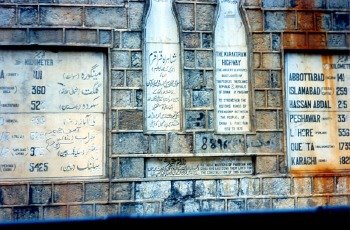Roof of the World
Sunday, December 16, 2012

The souls that pave the way for the modern tarmac road known as the Karakorum Highway (KKH) still seem to flicker amongst the sharp moving shadows of the unstable rocks and the almost countless but crumbly semi-transparent glaciers that constantly threaten its existence. There has always been a long pass into, and out of China and Pakistan over what is sometime called the "Roof of the World" but in ancient times it was a very hazardous passageway. One wonders how Alexander might have crossed the Karakorum Mountains in 325 BC or how early travellers like Marco Polo, Hieun Tsang and others might have tracked on the route without backpacks, four wheel driven powerful vehicles and even the roads, till Pakistan Army engineers spread asphalt through one of the most difficult terrain in the world and created this great engineering feat called as the eighth wonder of the world.Northern Pakistan has some of the most beautiful and mightiest mountain terrain -- Hindu Kush and Karakorum -- in the world.
What one sees while commuting on the highway? Extinct writings, Chinese traveller's diary and quoted in the North West Frontier Province Gazetteer that reads, "the path is certainly narrow, and often clung to the sheer faces of the many deep resonant gorges that confine their turgid, animated rivers. A traveller along the path sees at one glance the shadowy valleys from which a shiny mist columns rise at noon against a luminous sky, the forest ridges, stretches fold behind fold in softly undulating lines -- dotted by the white specks which mark the situation of Buddhist monasteries -- to the glacier draped pinnacles and precipices of the snowy range. He passes from the zone of tree ferns and endless colonnade of tall stemmed magnolias oaks and chestnut trees, fringes with delicate orchids and festooned by long convolvuluses to the region of gigantic pines, junipers, firs and larches. Down each ravine sparkles a brimming torrent, making the ferns and flowers nod as it dashes past them. Superb butterflies, black and blue, or flashes of rainbow colours that turn at pleasure into exact imitation of dead leaves, the fairies of this lavish transformation scene of nature, sail in and out between the sun light and gloom. The mountaineer pushes on by a track half buried between the red twisted stems of tree-rhododendrons, hung with long waiving lichens, till he emerges at last on open sky and the upper pastures -- the Alps of the Himalayan - field of flowers: of gentians and edelweiss and poppies, which blossom beneath the shining store house of snow that encompass the ice mailed and flouted shoulders of the giants of the range."
Get off the Grand Trunk Road -- main social as well as economic artery of Pakistan -- near Hassan Abdal; travel northeast through plains of Hazara and you are already in tourists' zone. Cyclists riding trendy machines and cellular phones even with local are commonly seen and almost all commodity items for the use offoreigners are available with vendors right on the roadside. Lucky ones may also have the pleasure to watch performance of Chinese artists at Silk Rout Festival that moves from place to place and gives spectacular performance.
Before crossing on the Chinese side of the Khunjerab Pass, the road passes through Hunza Valley. The intricate terraced fields, held in places by dry stone or wooden retaining walls and the complex system of irrigation channels leading down from mount Rakaposi or Ultar are testimony to the skilled labour of the locals who are famous for their different culture, friendly nature and long lives.
Labels: Travel
posted by S A J Shirazi @ 4:30 PM,
![]()
![]()
4 Comments:
- At 3:19:00 PM, said...
-
Greetings,
This is a inquiry for the webmaster/admin here at doodhpatti.blogspot.com.
May I use part of the information from your blog post above if I provide a link back to your website?
Thanks,
Peter - At 12:03:00 PM, Shirazi said...
-
Please go ahead. But who are you? Where are using the information?
- At 3:59:00 PM, said...
-
Hi there,
This is a question for the webmaster/admin here at doodhpatti.blogspot.com.
Can I use part of the information from this post above if I give a backlink back to this site?
Thanks,
Jack - At 1:46:00 PM, Zaffariqbal Durrani said...
-
Shirazi, this is such an article with so much of knowledge in it that it shall attract Tourist to the area. Thus is a great contribution from your side. I recon you try to publish this on other such sites which are globally accessible to the general public. Well Done





